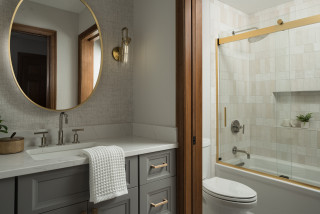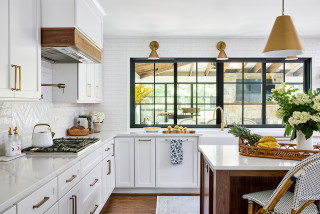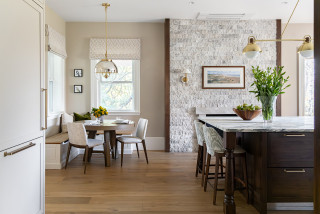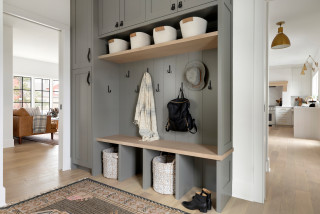
This article was originally published by a www.houzz.com . Read the Original article here. .

This article was originally published by a www.houzz.com . Read the Original article here. .

Moving back into a house after remodeling can be a bit like being in love. Are you not excited to use all your new appliances or plumbing fixtures? (Hello, new bathtub!) Is there not a smidge of giddiness as you think about coming home to your pristine new bathroom, kitchen or living room? Don’t deny it — you’re probably even babbling to the barista at Starbucks about your new space.
During this Happily Ever After stage, finally, the work is done! At last, there are no more nail guns and saws and vacuums making noise in your house. After months of destruction and disarray, it’s time to move back in and enjoy your home, sweet home, for the rest of your days (or at least until you sell it or remodel again). And though most of this phase is just you at last having the chance to enjoy the fruit of your general contractor’s labor, there are a few odds and ends that your contractor will be taking care of to make sure your Happily Ever After really lasts forever.
Find a general contractor on Houzz
This article was originally published by a www.houzz.com . Read the Original article here. .

Just like during the Honeymoon, a lot of visibly quantifiable work is being completed. Only this time, instead of things being torn up and thrown out, they’re being brought in and installed. The puzzle pieces are finally fitting together, and you are starting to see the big picture. (Dreamy sigh.)
I’ve harped repeatedly about how communication is key, and this still rings true during the Renewal of Vows stage. But patience is also important.
As you see new things being carried in and installed, it can be so tempting to begin moving back into your new space or using your new kitchen. But your contractor may still need some time and space to work.
There are last-minute items that will ultimately guarantee your satisfaction that need to be taken care of before you and your family can begin enjoying your new remodel. So hang in there, and your patience will be rewarded.
This article was originally published by a www.houzz.com . Read the Original article here. .

It’s around this time that I’ve often seen homeowners concerned about progress. Yes, plumbers are there, but where are the new sinks? Why isn’t there a single light fixture installed yet? Is the HVAC guy even working, or is he just taking a nap in the attic?
The other contributing factor to the crisis is the fact that any speed bumps that crop up during this phase take a bit more time to resolve. Overall, the placement of existing framing is the biggest obstacle in mechanical rough-ins.
If your plans specify that there is going to be a can light in Location A, but Location A has a structural beam directly above it — no can do. Or say your architect has designated a toilet to be mounted on the wall instead of on the ground, but existing wall framing prevents this from being a viable option. Back to the drawing board. Or maybe your HVAC contractor needs to be able to provide ductwork to a new vent hood location in your kitchen, but there is no open attic space to place the ducts. Time to think through the alternatives.
Another obstacle, which is less common but should still be noted, is the condition of existing mechanicals. Any wiring, plumbing or venting that is found to be damaged, dangerous or just not up to par with your municipality’s building code will likely need to be remedied.
And don’t even get me started on inspections. If your job is permitted, inspections for mechanicals will occur during this stage. City building inspectors are (at least where I’m from) well known for being thorough. If you don’t have everything just right (which ultimately is good, because they’re looking out for your safety), they will not hesitate to make your contractor fix the issue before any work can continue.
See why you should hire a professional who uses Houzz Pro software
This article was originally published by a www.houzz.com . Read the Original article here. .

To get a feel for this special home, they lived in it for a couple of years before calling in interior designer Clare Topham to gently refresh it. She worked on various rooms, updating the heating, decor and lighting, but the kitchen posed perhaps the biggest challenge. “It was a dinky little room,” Topham says. “[The owners] knew they wanted to extend, but didn’t want it much bigger. They only wanted to build what they needed for the two of them. They were never going to whack a modernist extension on the back.”
The owners are really happy with their finished kitchen, which respects their home’s heritage but is outfitted with the latest energy-efficient appliances. Read on to see the newly extended space.
This article was originally published by a www.houzz.com . Read the Original article here. .

Demolition Begins
A couple of weeks go by, and the day comes for work to start. Protective products are placed, and demolition begins. Demo, sweet, demo. Normally one of the quickest moving stages of a remodel, demolition makes it look as if a lot of work is being done practically overnight. Cabinetry is removed, walls are torn down, appliances are taken away and, in a matter of days or weeks (depending on the size of your project), you’re staring at a blank canvas.
After that, any necessary framing and structural work will begin. Framing usually isn’t as exciting or fast-paced as demolition, but still, there is visible progress almost daily. At this point, you and your partner are walking on air. The rate of work is astounding, and you’re still very excited (although maybe a little less nervous now) about the entire project.
Find a general contractor on Houzz
This article was originally published by a www.houzz.com . Read the Original article here. .

Whether you pick an elegant neutral, a rich dark tone or a zingy shade, the color you choose will have an effect on the look and feel of the whole room and could be the keystone of your entire kitchen design.
Color can be introduced to your kitchen in several ways, but the largest block of color will usually be the cabinets, so it’s worth giving this choice careful consideration.
In addition to personal preference, you’ll also need to take into account the direction your room faces, as this will affect the way colors are perceived. North-facing kitchens, for example, will have reflected rather than direct natural light, so using cooler colors can work better at keeping the space feeling brighter, while warmer tones will have a soft, gentle quality.
South-facing kitchens, in contrast, will receive direct light, so stronger, brighter colors will look vibrant here. If you love reds and oranges, these can work well in a south-facing space. A sunny room can also handle darker colors well, because the light is so intense.
If you’re feeling overwhelmed, start by saving your favorite kitchen color photos in a Houzz ideabook and ask a professional to help guide you through the best options for your space.
New to home remodeling? Learn the basics
This article was originally published by a www.houzz.com . Read the Original article here. .

As mentioned, there’s a lot that goes into a bathroom remodel. Depending on the size and scope of your project, the process can take from six weeks to eight months or more, according to the National Kitchen & Bath Association. And while some of it can be done on the fly, you’re much better off the more prepared you are.
It’s ideal to have every last detail planned, and every material picked out and ordered, before construction starts. The last thing you want is to get halfway through your remodel and have to tell your construction crew to take a two-week break while you wait for that back-ordered marble to arrive from Italy.
You’ll want to nail down the nuts and bolts of how things will flow and where things will generally be placed. You’ll need a dry space to store your materials, so you’ll need to plan on where you’re going to keep everything while construction is underway. Can you make space in your garage or on the side of your house?
Are you prepared for the project and disruption? What time will the workers be there, and will someone be on-site to answer questions and oversee the construction? Will it affect your work schedule or any trips? Where will you shower during construction? Who in your family will be available should something come up? Think about how long the crew will be there and if the materials will arrive in time. Any last-minute decisions need to take top priority to ensure a smooth-running project.
Your Guide to a Smooth-Running Construction Project
This article was originally published by a www.houzz.com . Read the Original article here. .

For the most successful remodel, you’ll want to consider how you live now and how you’d like to live ideally. After all, remodeling is a chance to set new, more organized habits. Why not create a home that will make implementing your new habits easier? Here are four questions I recommend that you consider before you remodel.
This article was originally published by a www.houzz.com . Read the Original article here. .
Unless you’re planning a wet room, you don’t need to cover every inch with tile, Ghaly says. Not only is tiling just part of the room cheaper, both in terms of labor and materials, but also it’s often more practical.
“The advantage of part-tiling is that the bathroom becomes much more flexible,” he says. “For example, you can paint the rest of the walls, which means the bathroom can be redesigned more easily in the future, using different colors.
“Hanging pictures on bathroom walls is also becoming popular, and part-tiling gives you this option,” he adds.
When it comes to tile prices, Ghaly says, ceramic tiles are generally cheaper. “Imitation tiles — marble-look, for example — can be inexpensive yet will give your bathroom a similar luxury look and feel like the real thing.”
Shop for bathroom tile on Houzz